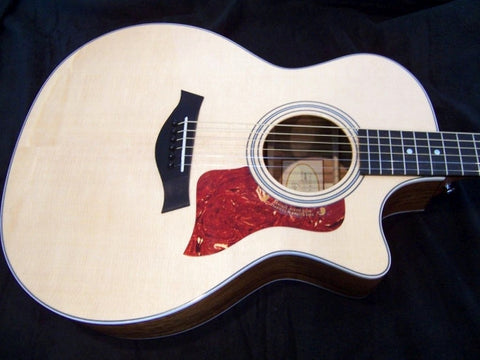That infamous nitro (nitrocellulose) haze on Strat and Les Paul guitars
Haze, residue, and fog so common with nitrocellulose instruments like many Fender Strat and Gibson Les Paul guitars is normally very resistant to cleaning due to years of playing. It builds up over time, and before you know it these instruments often show a dirty fog or haze that just wont all seem to wipe off with typical cleaning methods, especially in areas where your arm touches the finish.
Fortunately our Guitar Scratch Remover Player's Kits will wipe away nitro haze buildup from playing in an instant (see end of article for before and after shots).

Nitrocellulose, or nitrocellulose lacquer, was the first spray-on finish, invented in the early 1920s for the automotive industry.  It has since been used on everything from furniture to guitars. Polyurethane style finishes came nearly two decades later. How do you know if your guitar finish is nitro or poly? An experienced guitar shop can tell you, but if your guitar was made in Asia or Mexico it is very likely a polyurethane-type finish. Polyurethane is actually a high quality plastic or liquid plastic finish. These finishes are durable and cheaper to mass-produce. If you have a USA made Gibson Les Paul or USA Fender Strat it is likely you have a nitrocellulose finish (although Fender has been making USA Strats for awhile now with poly finishes, but still uses nitro finishes on some guitars). Many smaller custom shops in the USA and worldwide still use nitro finishes also.
It has since been used on everything from furniture to guitars. Polyurethane style finishes came nearly two decades later. How do you know if your guitar finish is nitro or poly? An experienced guitar shop can tell you, but if your guitar was made in Asia or Mexico it is very likely a polyurethane-type finish. Polyurethane is actually a high quality plastic or liquid plastic finish. These finishes are durable and cheaper to mass-produce. If you have a USA made Gibson Les Paul or USA Fender Strat it is likely you have a nitrocellulose finish (although Fender has been making USA Strats for awhile now with poly finishes, but still uses nitro finishes on some guitars). Many smaller custom shops in the USA and worldwide still use nitro finishes also.
While both poly and nitro can be high gloss, nitro is noticeably just a bit less glossy than poly finishes. Usually your guitar manufacturer’s website will say if your model has a nitrocellulose finish. When you look at the thousands of guitars models produced each year by so many companies, poly finishes generally outnumber nitro today, with a good mix of both still available at most local guitar shops.
Nitrocellulose is actually a plant-based finish, it coats the guitar like a standard finish but remains ‘open’, porous, and ‘breathes’ more than modern polyurethane finishes. Nitro definitely has more of a vintage appearance. Though often debated, nitro is believed by many people to allow the guitar wood to vibrate better when playing the guitar strings. This finish does not smother and ‘encase’ the wood like a poly finish can - for these reasons it is preferred by many players as a premium finish & those after the best tone. Some believe this is even of greater importance on acoustic guitars where the wood vibrates more. Nitro costs more which is why it is more likely to be found on more expensive and mostly USA-built guitars. This includes electric and acoustic guitars. Martin and Gibson are known for their premium acoustic guitars, many with nitrocellulose finishes. Others like the durability of polyurethane and polyester guitar finishes. At one time Taylor Guitars used nitrocellulose finishes but has moved to polyester due to durability on most of their guitars.  Unfortunately nitro is less durable, so over time nitro can get residue or buildup, or break down - even without being touched or simply from environmental exposure. Nitrocellulose ‘yellows’ and cracks more (also called ‘finish checking’) than polyurethane and polyester finishes. Nitro is also more prone to fine scratches as it’s a softer clearcoat.
Unfortunately nitro is less durable, so over time nitro can get residue or buildup, or break down - even without being touched or simply from environmental exposure. Nitrocellulose ‘yellows’ and cracks more (also called ‘finish checking’) than polyurethane and polyester finishes. Nitro is also more prone to fine scratches as it’s a softer clearcoat.
One of the more common issues with nitro finishes is residue from oils and acids in our hands will react or stick to the surface of the nitrocellulose finish. Almost anyone with a nitro finish on a Gibson Les Paul or Fender USA Strat will recognize this telltale fog and haze, usually on the upper part of the guitar where your arm rests, and it can be felt on top of the finish as a non-glossy residue (this is different from nitro that fogs from environmental moisture and age). On black guitars this haze residue really stands out. It can be very challenging to remove, especially if it’s built up over a long time; usual polishes won’t do a thorough job cleaning up where you arm or hand rested. 

Rest easy though - these perspiration stains and residue areas will disappear in a few short moments of polishing with the Player's Kit. You will be amazed how well years of haze or residue-coated high gloss nitro finish cleans up with the Player’s Kit Guitar Scratch Remover. Check out the before and after photos of a nitro finish restored with the Player’s Kit in just a few short minutes, and look at that new sharp reflection, wow! Restores worn and dirty finishes and works great on your scratches, too! Thanks for reading. 
